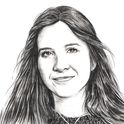Osman Yousefzada’s 2018 art installation, A Migrant’s Room of Her Own, was based on his mother’s bedroom. But when he took her to see it at the Ikon Gallery in Birmingham, she was confused. “She asked me who slept there,” Yousefzada says. “She’d never been to a museum before.”
Yousefzada’s mother emigrated to England from a village on the border of Afghanistan and Pakistan in the 1970s, following her husband who had left seven years earlier. Both were illiterate and spoke no English. They lived in a tight-knit Muslim community in Balsall Heath, Birmingham. Yousefzada’s mother, a seamstress, did not leave the house. When they hit puberty, his three sisters were taken out of school and the family concocted elaborate excuses for social workers asking about their sudden disappearance.
Yousefzada, an artist and fashion designer whose clothes have been worn by Beyoncé, Taylor Swift and Lady Gaga, describes his childhood in his new memoir, The Go-Between. He would buy fabrics and bring them home for his mother: observing her work, he writes, was “like watching a magician.” He tells me that the book is “a bit of a love letter” to his mother, who died on New Year’s Day this year. Yousefzada looked after her during the pandemic. “It was really beautiful,” he says. “It’s that connection from one body to another body. You’re connected and you have this responsibility for each other.”
He had a more difficult relationship with his father, a “complicated” man who sometimes beat his wife and told Osman he should have killed his younger sister after she ran away from home. When Osman left home permanently after his first year studying anthropology at SOAS in London, his father burned his belongings.
Years later, they reconciled. “I think he understood logically why I left to go to university. He probably tried to understand why I didn’t come back.”
After graduating from SOAS, he studied fashion at Central Saint Martins, and in 2008 founded his clothing label, Osman. Does he ever wonder what he would be doing if he hadn’t left home at 18? “Maybe working in a factory,” he replies. “I do think my life would be quite different.”
The Go-Between depicts Balsall Heath in the 1980s and 1990s, where immigrant families lived in cheap housing on streets frequented by sex workers. “It’s a very working-class book,” he says. “It’s a very under-class book. The root is from illiteracy—the root is not being able to have the codes to navigate new spaces. And it’s a story of quite a few people.”
Becoming an artist was not a difficult step for Yousefzada. “I come from a family of artisans, so making stuff with your hands comes quite naturally and easily.” But he can see the difference between how his work is now perceived compared to his mother’s. “Most working-class people are artisans, and most middle-class people are artists.”
Yousefzada’s parents used to warn their children that they risked being sent back by the UK authorities to the Afghan-Pakistani border. He was reminded of those childhood conversations by the recent Nationality and Borders Bill, which would make it easier for the government to strip dual nationals of British citizenship. “I find that makes me quite nervous,” he says. “Where do you redefine the boundaries of where you belong?”
He is furious about the way the UK treats migrants. “We may as well have Priti Patel on the Channel on one of those news boats actually following migrants across. I mean, it’s completely crazy how we treat people… who come here for a better life.”














